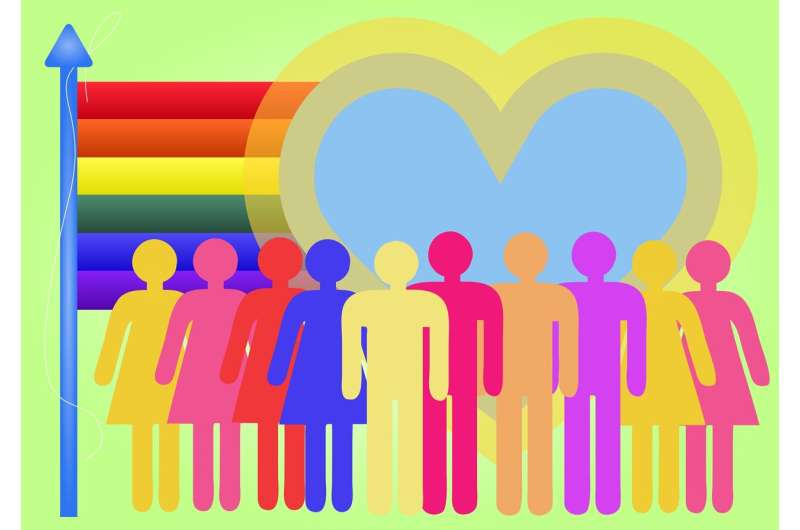
Sexual orientation—dictated by factors like sexual identity, attraction and behavior—is challenging to measure comprehensively. This is reflected in variations in the number of lesbian, gay, bisexual and transgender people recorded across surveys using different measurement approaches.
Most approaches focus on “sexual identity” to understand mental health disparities, but differences in perceived notions of “identity” and “attraction/behavior” are prevalent. For instance, some individuals report same-sex attraction but identify as heterosexual in surveys. This suggests an invisible sexual minority group—those who do not align with traditional labels, yet experience similar mental stress as other sexual minorities—remaining unrecognized by policies aimed at mental health support.
To improve the inclusivity and relevance of current sexual orientation measurements, Assistant Professor Dr. Nicole F. Kahn from University of Washington and a research team have published a study in the American Journal of Public Health.
Dr. Kahn explains, “The purpose of this study was to describe and compare responses from respondents asked to complete two different survey questions designed to measure sexual orientation and understand how variation in responses to these questions are associated with mental health outcomes.”
The team hypothesized that measures using a broader continuum of sexuality would identify more sexual minority (SM) respondents than those using narrower labels, and that individuals identifying as heterosexual on one survey and SM on another would show mental health patterns similar to SM respondents in both surveys.
The National Longitudinal Study of Adolescent to Adult Health (Add Health) includes a cohort of adolescent school students who were followed from 1994–1995 (wave I) until 2016–2019 (wave V), with wave VI ongoing. Between 2020 and 2021, participants from the Add Health study were invited to complete the Sexual Orientation/Gender Identity, Socioeconomic Status, and Health Across the Life Course (SOGI-SES) survey.
Dr. Kahn notes, “Participants who identified as mostly heterosexual, bisexual, mostly homosexual or homosexual; reported same-sex partners in waves III, IV or V; or were discordant on sex assigned at birth and gender expression (e.g., androgynous or gender nonconforming) in wave V, were all solicited for participation in SOGI-SES. We refer to these respondents as sexual and gender minorities (SGMs).”
In the study, respondents answered two questions on sexual orientation: one from the Add Health survey providing a continuum ranging from “100% heterosexual” to “not sexually attracted to either males or females,” and the second from the National Health Interview Survey (NHIS) offering fewer options.
Those identifying as “heterosexual (straight)” on both surveys were classified as such, while those choosing non-heterosexual options in both were categorized as sexual minorities. A third group, termed “undetected sexual minorities,” included those who marked “100% heterosexual (straight)” in one survey but a sexual minority option in the other.
Mental health outcomes were assessed by asking respondents whether they had ever been diagnosed with conditions like depression, anxiety or panic disorders. Gender was assigned based on alignment between sex at birth and current gender identity.
Of the 2,576 respondents, Dr. Kahn observed, “A larger proportion of cisgender male (93.9%) and cisgender female respondents (91.2%) identified as ‘straight’ in response to the NHIS question compared with cisgender males (92.2%) and cisgender females (79.1%) who identified as ‘100% heterosexual’ in response to the Add Health question.”
This study finds that Add Health questions were able to detect more SMs than the NHIS questions (14.4% vs. 6.8%). Interestingly, cisgender females were significantly more likely to be undetected by NHIS than cisgender males (12.8% vs. 2.6%).
With respect to the mental health outcomes, SMs and undetected SMs were more likely to report a depression diagnosis than heterosexual respondents. Similarly, anxiety or panic disorder diagnoses were significantly different only between SMs and heterosexual or straight respondents among both cisgender male (46.3% vs. 30.1%) and cisgender female respondents (54.7% vs. 37.1%).
Current measures of sexual orientation may lead to underestimation of the SM population, thereby underestimating the health disparities they experience.
“Further research on other measures that consider response options that reflect a broader continuum of sexuality are needed to inform health policy and service planning to meet the needs of the sexual minority population,” concludes Dr. Kahn.
More information:
Assessment of Health Disparities and Sexual Orientation Response Choices Used in Two US National Population Based Health Surveys, 2020–2021, American Journal of Public Health (2024). DOI: 10.2105/AJPH.2024.307839
Provided by
American Public Health Association
Citation:
Study links variation in sexual orientation measurement to mental health disparities (2024, November 7)
retrieved 7 November 2024
from https://medicalxpress.com/news/2024-11-links-variation-sexual-mental-health.html
This document is subject to copyright. Apart from any fair dealing for the purpose of private study or research, no
part may be reproduced without the written permission. The content is provided for information purposes only.


